Start with a circle and let two points go around it, one twice as fast as the other. At each step of the way, draw a line to connect the points. You'll get a picture similar to the one above. This set of lines somehow clearly draws a cardioid. This is an example of a mathematical envelope.(For a gallery of envelopes that is way better than this one, see this.)
The official definition of a mathematical envelope is a bit tricky, so we offer just a pseudo-definition. A "family" of lines is an infinite set of lines, sharing some common trait. In the case above, the common trait is that each line goes through two specially chosen points on a circle. (We of course don't show the whole family, just about 100 of the lines.) The envelope of a family \(F\) of lines is a curve \(C\) such that each line is tangent to \(C\) at a point, and that for each point on \(C\), there is a line in \(F\) that is tangent to \(C\) at that point.
There are tons of interesting ways of creating envelopes. We start by adjusting the process above. Instead one circle traveling twice as fast as the other, what if one moves only 1.5 times as fast? We get the image below, another cardioid.
One point going around four times as fast as the other gives this image.
You can make your own! When you get some free time, or are wishing you were somewhere else (like when you are in the middle of English class, or a faculty meeting, or getting your molars pulled or spleen removed), pick your own pattern for dot connecting and try it on the image below, with dots helpfully numbered for you. (I highly recommend starting with the "twice as fast" method first, where 1 is connected to 2, 2 to 4, etc. As you go around, note that 30 goes to 60, which is 0 on the diagram, and 31 goes to 62 \(\equiv\) 2, etc.)
If you put pins on a board in the above locations and connect dots with strings, you get string art.
It is a common calculus exercise to note that if \((x,y)\) lies on a circle centered at the origin, then the tangent line has slope \(-y/x\). So it should be no surprise that drawing a bunch of lines through \((\cos\theta,\sin\theta)\) with slope \(-\sin\theta/\cos\theta\) gives the following image:
One of the fun things about all of this is that one can play. Using Mathematica as we do, it isn't hard to change the slopes of the lines and see what comes out. Changing the above slopes from \(-\sin\theta/\cos\theta\) to \(\sin\theta/\cos\theta\), we get this image:
This shape has a name. We don't know what it is. (It may be an astroid.) There are ways of determining what the envelope are, but we won't go into that here.
A famous way of creating envelopes is to start with a known curve, then draw through each point a line perpendicular to the curve at that point. This is called the evolute. (The evolute is also the set of all centers of circles of curvature, if you know what that means.) Below, we start with a parabola, then draw the perpendicular lines:
We show one more, starting with an ellipse:
One doesn't have to use a family of lines to create envelopes; any curve will do. Below, we start with a circle \(C\) and a point \(C\) on that circle. Our family of curves is the set of circles with center on \(C\), each passing through \(P\).
Another cardioid! Pretty cool.
Again, you can use any kind of curve to create an envelope. In the following image we use a family of parabolas. One can define a parabola with a line, called the directrix, and a point, called a focus. We create a family of parabolas by using the red line as the directrix for all the parabolas; the foci for the parabolas lie on the blue parabola, and are indicated with the yellow dot. The image it creates is our MathGifs logo.
Envelopes are important beyond their ability to make pretty pictures. The picture of the cardioid above is related to the sensitivity of certain microphones to sound. In a later post we'll show how we can understand sonic booms in terms of envelopes.
Don't forget to print out the pic of the points on the circle above and make your own envelopes. If you come up with something cool, show us in the comment section below. If it is really cool, fold it up, put a stamp on it, and mail it to us. Then your envelope really becomes a ... nevermind. Too meta.










This comment has been removed by a blog administrator.
ReplyDeleteThis is absolutely gorgeous! thanks for sharing :)
ReplyDeleteThis comment has been removed by the author.
ReplyDelete